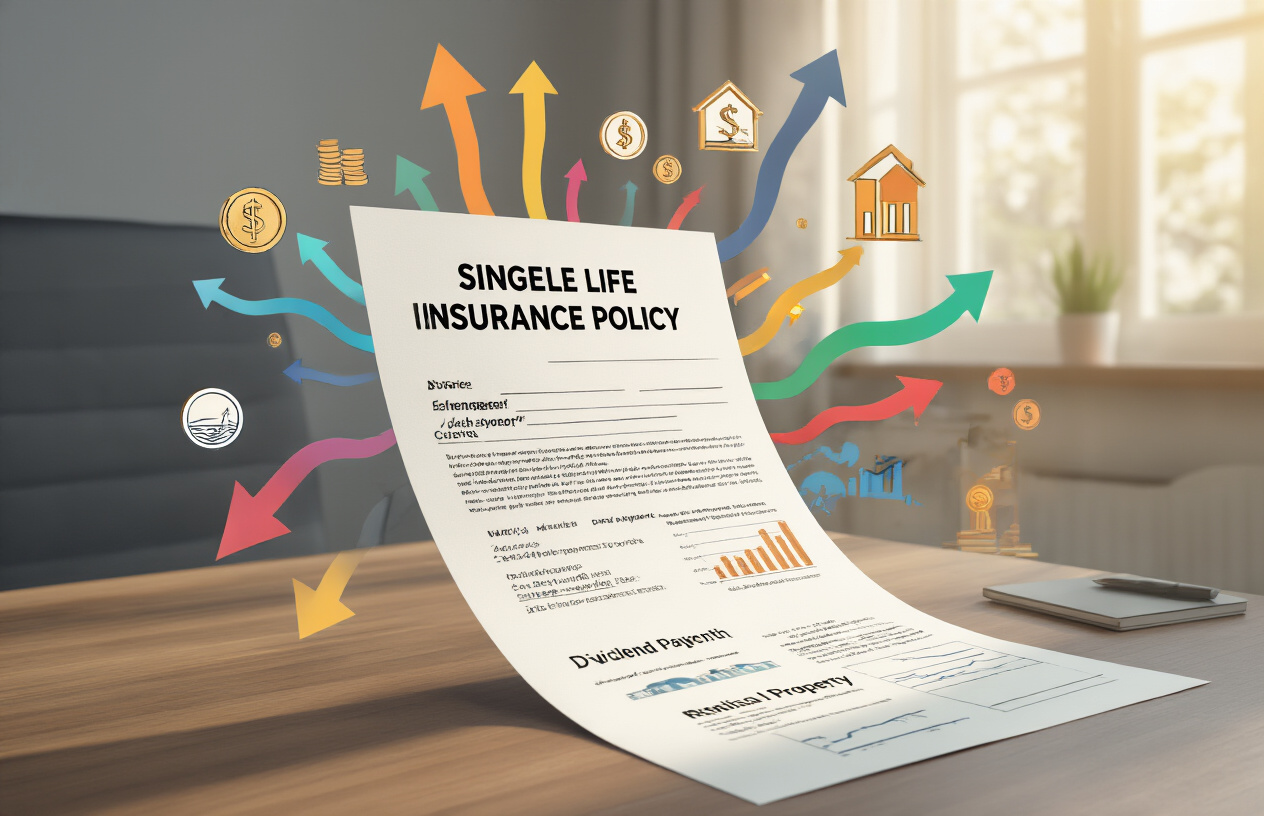The 7 Wealth-Building Secrets of Life Insurance
“Life insurance is the only tool that guarantees the creation of an estate immediately, regardless of when death occurs.” - Ben Feldman (One of the most successful life insurance salesmen in history)
The 7 Wealth-Building Secrets of Life Insurance

Life insurance isn't just about protecting your family anymore. Smart investors are discovering how to turn these policies into powerful wealth-building machines that grow money tax-free while keeping their principal safe.
This guide is for business owners, high-income earners, and anyone tired of watching taxes eat away at their investment gains. You'll learn strategies the wealthy have used for decades to multiply their money in ways most people never consider.
We'll show you how to transform your life insurance into a tax-free investment vehicle that generates guaranteed returns without market risk. You'll discover how to create your own personal banking system that puts you in control of your money, plus learn advanced techniques for leveraging policies to accelerate wealth building. We'll also cover how proper policy structuring can help you transfer wealth to the next generation while minimizing tax consequences.
These seven secrets can change how you think about building and protecting wealth for life.
Transform Life Insurance into a Tax-Free Investment Vehicle

Build Wealth Without Annual Tax Penalties on Growth
Unlike traditional investment accounts that get hit with taxes every year, properly structured life insurance policies let your money grow without the IRS taking a slice annually. When you invest in mutual funds or stocks in a taxable account, you pay taxes on dividends, interest, and capital gains distributions - even if you never touch the money. This constant tax drag can eat away 1-2% of your returns each year.
Life insurance cash value accumulates tax-deferred, meaning every dollar of growth stays in your account to compound. Over decades, this creates a massive advantage. A $10,000 annual contribution growing at 6% would reach $790,000 after 30 years in a life insurance policy, compared to roughly $580,000 in a taxable account assuming a 25% tax rate.
The real power comes from the compound effect. When you're not losing money to taxes each year, you're earning returns on money that would have otherwise gone to the government. This accelerates wealth building significantly, especially for high earners who face steep tax brackets on their investment gains.
Access Cash Value Through Tax-Free Loans During Your Lifetime
Most people don't realize they can access their life insurance cash value without triggering a taxable event. Policy loans allow you to borrow against your accumulated cash value at competitive interest rates, typically 4-6% annually.
Here's where it gets interesting: these loans aren't technically withdrawals, so the IRS doesn't consider them taxable income. You can borrow up to 90% of your cash value for any purpose - buying real estate, funding a business, paying for education, or covering emergencies.
The borrowed amount continues earning returns within the policy, often at rates higher than the loan interest rate. Some policies offer wash loans where the loan rate equals the crediting rate, making the cost of borrowing essentially zero.
Smart wealth builders use this strategy to access capital for investments while keeping their life insurance growth engine running. You're essentially using the insurance company's money while your cash value keeps compounding. When structured properly, you never have to pay back these loans - the death benefit simply gets reduced by the outstanding loan amount.
Pass on Death Benefits Completely Free From Income Taxes
Death benefits from life insurance policies pass to beneficiaries completely income tax-free under current tax law. This creates powerful wealth transfer opportunities that other financial instruments simply can't match.
Consider a business owner who builds $2 million in cash value over their lifetime while maintaining a $5 million death benefit. When they pass away, beneficiaries receive the full $5 million without paying a penny in income taxes. Compare this to inheriting a $5 million IRA, which would trigger massive tax bills for the beneficiaries.
The tax-free nature of death benefits makes life insurance particularly valuable for estate planning. Wealthy families often use life insurance to pay estate taxes, ensuring their heirs receive maximum value from inherited assets. The death benefit can cover the tax bill while preserving other family assets intact.
This benefit becomes even more powerful when combined with irrevocable life insurance trusts (ILITs), which can remove the death benefit from your taxable estate entirely, avoiding both income and estate taxes.
Avoid the Tax Burden That Destroys Traditional Retirement Accounts
Traditional retirement accounts like 401(k)s and IRAs create a ticking tax time bomb. Every dollar withdrawn gets taxed as ordinary income, and required minimum distributions force you to take money out starting at age 73, whether you need it or not.
Life insurance offers a completely different approach. Since policy loans aren't taxable income, you can create tax-free retirement income without the restrictions and mandatory distributions of traditional accounts. You control when and how much you access, giving you flexibility that retirement accounts simply can't provide.
The tax advantages become more pronounced as you age. While retirees with large IRA balances face increasing tax bills due to required distributions, life insurance cash value continues growing tax-deferred. This creates a hedge against rising tax rates in retirement.
Many financial advisors now recommend the "tax-free trilogy" - combining Roth IRAs, municipal bonds, and life insurance to create multiple sources of tax-advantaged income. Life insurance often provides the largest pool of accessible, tax-free dollars in this strategy.
Account Type Annual Growth Taxation Access Taxation Required Distributions Control 401(k)/IRA Tax-deferred Ordinary income Yes, starting at 73 Limited Taxable Account Annual taxes on gains Capital gains rates No Full Life Insurance Tax-deferred Tax-free loans No Full
Generate Guaranteed Returns While Protecting Your Principal

Lock in minimum growth rates regardless of market volatility
Whole life insurance policies offer something the stock market simply can't match: guaranteed minimum growth rates that never drop below a specific floor. Most quality policies guarantee annual growth rates between 2% and 4%, regardless of what happens in the broader economy. This means your cash value grows steadily year after year, even during recessions, market crashes, or periods of economic uncertainty.
Unlike variable annuities or investment accounts that can lose value during market downturns, your life insurance cash value continues its upward trajectory. The insurance company assumes all the investment risk, leaving you with the peace of mind that comes from predictable, steady growth.
Protect your money from stock market crashes and economic downturns
Stock market volatility can destroy decades of wealth building in a matter of months. The 2008 financial crisis wiped out trillions in retirement accounts, and many investors never fully recovered. Life insurance cash value sits completely outside the stock market ecosystem, making it immune to these devastating losses.
Your policy's cash value grows in a separate account managed by the insurance company's general fund. This fund typically invests in high-grade bonds, real estate, and other stable assets that provide steady returns without the wild swings of equities. During the Great Recession, while 401(k) accounts lost 30-40% of their value, life insurance policies continued growing at their guaranteed rates.
This protection becomes even more valuable as you approach retirement age, when you have less time to recover from major losses. Traditional financial advisors often recommend reducing stock exposure as you get older, but with life insurance, you never need to worry about sequence-of-returns risk destroying your wealth.
Earn dividends from mutual insurance company profits
Mutual life insurance companies operate differently from publicly traded insurers. Instead of paying profits to shareholders, they return excess earnings to policyholders through annual dividends. These dividends represent your share of the company's investment gains, mortality experience, and operational efficiency.
Top-tier mutual companies like Northwestern Mutual, MassMutual, and New York Life have paid dividends consistently for over 100 years, including during the Great Depression and every major economic crisis since. While dividends aren't guaranteed, this track record speaks volumes about the stability and profitability of the mutual insurance model.
Dividend rates from quality companies typically range from 5% to 7% annually, significantly boosting your policy's overall performance beyond the guaranteed minimum. You can take these dividends as cash, use them to reduce premiums, or reinvest them to purchase additional coverage and cash value - accelerating your wealth accumulation.
Compound your wealth without risk of principal loss
The combination of guaranteed growth plus dividends creates a powerful compounding engine that never goes backward. Your cash value grows on both the guaranteed portion and any dividends earned, creating compound growth on top of compound growth.
Consider this example: A $10,000 annual premium paying policy with a 3% guarantee and 5% dividend could grow to over $500,000 in cash value over 20 years, with zero risk of principal loss. Compare this to a market-based investment that might average higher returns but could lose 20-40% during bad years, forcing you to restart the compounding process multiple times.
The psychological benefits of guaranteed growth shouldn't be underestimated either. When you know your money is growing steadily regardless of external conditions, you're more likely to stay consistent with your wealth-building strategy instead of panicking and making emotional decisions during market turbulence.
This guaranteed compounding also provides a solid foundation for more aggressive wealth-building strategies. You can take calculated risks with other investments knowing your life insurance provides a stable base that will never disappear.
Create Multiple Income Streams from a Single Policy

Receive regular dividend payments as passive income
Participating whole life insurance policies offer something unique in the financial world: the potential for annual dividend payments that can create steady passive income. These dividends come from the insurance company's profits and represent your share as a policyholder-owner of a mutual company.
What makes these dividends particularly attractive is their tax treatment. The IRS considers them a return of premium rather than taxable income, which means you can receive thousands of dollars annually without paying taxes on the distributions. This tax-free characteristic makes dividend-paying life insurance an incredibly powerful wealth-building tool.
The dividend payments aren't guaranteed, but top-tier mutual insurance companies have maintained consistent dividend payment histories spanning decades. Some companies have paid dividends to policyholders for over 150 consecutive years, demonstrating remarkable stability even through economic downturns, wars, and market crashes.
You have multiple options for handling these dividend payments. You can take them as direct cash payments to supplement your income, use them to purchase additional paid-up insurance coverage, or leave them to accumulate with interest inside the policy. This flexibility allows you to adapt your strategy based on changing financial needs and market conditions.
Borrow against cash value for investment opportunities
The cash value in your life insurance policy serves as collateral for low-interest policy loans, creating a unique financing mechanism for investment opportunities. Unlike traditional bank loans, policy loans don't require credit checks, income verification, or lengthy approval processes. You're essentially borrowing your own money.
Policy loan interest rates typically range from 5-8%, significantly lower than credit cards, personal loans, or many business loans. The borrowed amount continues earning dividends inside the policy, creating an arbitrage opportunity where your money works in two places simultaneously.
This strategy becomes particularly powerful for real estate investments, business opportunities, or stock market investments. You can access capital quickly when time-sensitive opportunities arise, without disrupting your long-term wealth accumulation strategy. The policy continues growing as if you never borrowed against it.
The loan repayment terms are entirely flexible. You can make interest-only payments, principal and interest payments, or no payments at all. If you choose not to repay the loan, the outstanding balance plus interest will be deducted from the death benefit, but this doesn't affect the policy's viability or your access to future loans.
Use policy loans to fund real estate purchases
Real estate investors have discovered that life insurance policy loans can be game-changers for property acquisitions. The speed and simplicity of accessing policy loans make them ideal for competitive real estate markets where quick cash offers win deals.
Consider a scenario where you identify an undervalued rental property. Instead of going through traditional mortgage processes that take 30-45 days, you can access policy loan funds within days. This speed advantage often allows you to negotiate better purchase prices and secure properties that other investors miss due to financing delays.
The beauty of this strategy lies in the numbers. Your policy loan might carry a 6% interest rate while the rental property generates 8-12% returns through cash flow and appreciation. You're using the insurance company's money to purchase assets that produce higher returns than the cost of borrowing.
Many sophisticated real estate investors use this approach for fix-and-flip projects. They access policy loans for initial purchases and renovation costs, then refinance with traditional mortgages or sell the property to repay the policy loan. This creates a revolving source of investment capital that doesn't depend on banks or market conditions.
Generate retirement income without touching your principal
Perhaps the most elegant wealth-building aspect of properly structured life insurance involves retirement income generation. Through strategic policy loans, you can create tax-free retirement income while preserving your principal and death benefit.
The process works by borrowing against your accumulated cash value during retirement years. Since policy loans aren't considered taxable income, you receive money without tax consequences. Meanwhile, your original cash value continues earning dividends, potentially offsetting loan interest charges.
This approach offers several advantages over traditional retirement accounts. Unlike 401(k)s or IRAs that force required minimum distributions starting at age 73, life insurance policies have no mandatory withdrawal requirements. You control when and how much income to access based on your needs rather than IRS rules.
The death benefit provides additional security for your heirs. Even if you've borrowed substantial amounts during your lifetime, your beneficiaries typically receive a significant death benefit. This creates a win-win scenario where you enjoy tax-free income while alive and leave a legacy for your family.
Smart retirement planning often involves using policy loans to bridge the gap between early retirement and Social Security eligibility, allowing other retirement accounts more time to grow while providing immediate income needs.
Leverage Your Money for Maximum Wealth Creation

Control Large Amounts of Capital with Relatively Small Premium Payments
Life insurance operates on a unique leverage principle that most investors overlook. When you purchase a $1 million policy, you gain control over that full death benefit amount from day one, even though your premium might only be $10,000-$30,000 annually. This creates an immediate leverage ratio of 33:1 to 100:1 - something virtually impossible to achieve in traditional investments.
Consider this: A 35-year-old purchasing a $500,000 whole life policy might pay $8,000 annually. If something happens in year two, their beneficiaries receive the full $500,000, representing a 6,150% return on the $16,000 invested. Even in later years, the death benefit continues to exceed total premiums paid by substantial margins.
This leverage extends beyond death benefits. The cash value component grows tax-deferred, and you can borrow against it without triggering taxable events. Many policies allow loans up to 90% of cash value, effectively letting you access your money while it continues growing.
Use Borrowed Money to Pay Premiums and Accelerate Growth
Premium financing takes life insurance leverage to another level. High-net-worth individuals regularly use bank loans to pay premiums on large policies, essentially using other people's money to build wealth. The strategy works because life insurance returns often exceed borrowing costs, especially in today's low-interest environment.
Here's how it works: You secure a loan at 4-6% interest to pay premiums on a policy earning 6-8% guaranteed returns. The difference becomes your profit margin. Banks readily provide these loans because the policy serves as collateral, making it a secured transaction.
Smart investors also use existing policy cash values to pay premiums on additional policies. This creates a compounding effect where one policy funds another, exponentially increasing your insurance portfolio without additional out-of-pocket expenses.
Create Instant Estate Value Far Exceeding Your Investment
Life insurance delivers immediate estate multiplication that no other financial vehicle can match. A business owner paying $25,000 annually creates instant estate value of $1-2 million. This immediate wealth creation provides security for families and business continuity that would take decades to achieve through traditional investing.
The math becomes even more compelling with survivorship policies. A married couple in their 50s might pay $15,000 annually for a $2 million second-to-die policy. When both spouses pass, their heirs receive $2 million tax-free - money that funds estate taxes, equalizes inheritances, or provides liquid assets when the estate consists primarily of illiquid business interests or real estate.
Multiply Your Purchasing Power Through Strategic Policy Design
Modern life insurance policies offer flexible design options that amplify wealth-building potential. Modified Endowment Contracts (MECs) allow maximum cash funding for investors prioritizing growth over death benefits. Paid-up additions riders let you overfund policies, accelerating cash value accumulation.
Universal life policies with secondary guarantees provide maximum death benefit coverage at minimum cost, freeing up capital for other investments. Variable policies offer equity market exposure within the tax-advantaged insurance wrapper, potentially delivering higher returns while maintaining principal protection.
Policy Type Best For Leverage Advantage Whole Life Conservative growth, guaranteed returns Predictable leverage with steady premiums Universal Life Flexible premium investors Adjustable leverage based on performance Variable Life Growth-oriented investors Market upside with downside protection Survivorship Estate planning Maximum leverage for married couples
The key lies in matching policy design to your specific wealth-building objectives, risk tolerance, and timeline.
Build a Personal Banking System You Control

Become your own bank by lending to yourself at favorable rates
When you borrow against your life insurance policy's cash value, you're essentially lending money to yourself. The insurance company provides the loan using your policy as collateral, but here's the beautiful part - your cash value continues earning interest even while you're using the borrowed funds. You set up a win-win scenario where you access capital while your money keeps growing.
Traditional bank loans come with rigid interest rates determined by market conditions and your credit score. With policy loans, you typically pay interest rates between 4-8%, often lower than credit cards or personal loans. Some policies even offer variable rates tied to dividend performance, creating opportunities for even more favorable borrowing costs.
Eliminate dependence on traditional banks and their approval processes
Banks love asking intrusive questions about your financial life. They want to know your income, debts, spending habits, and future plans. They run credit checks, require mountains of documentation, and can deny your application for reasons beyond your control. Market volatility, economic downturns, or changes in lending standards can slam the door shut on your borrowing needs.
Life insurance policy loans skip this entire circus. No credit applications, no income verification, no waiting periods. You own the cash value - it's your money. The insurance company simply advances funds against your accumulated value. Bad credit history? Doesn't matter. Recent job change? Irrelevant. Economic recession tightening credit markets? Your policy loan availability remains unaffected.
This independence becomes particularly valuable during financial emergencies or when opportunities require quick action. While others scramble for bank approvals, you access funds within days, sometimes hours.
Keep interest payments within your own financial ecosystem
Every dollar you pay in interest to traditional lenders leaves your financial ecosystem forever. Credit card companies, banks, and mortgage lenders profit from your interest payments while you receive nothing in return. This represents a massive wealth leak that most people never calculate.
Policy loans flip this dynamic. The interest you pay goes back into the insurance company's general account, which supports dividend payments to policyholders. As a participating policyholder, you share in these profits through annual dividends. Your interest payments essentially cycle back to benefit you indirectly through enhanced policy performance.
Some whole life policies offer even more direct benefits. Mutual insurance companies return excess profits to policyholders as dividends. The interest you pay helps generate these returns, creating a circular flow where your borrowing costs contribute to your policy's growth.
Maintain complete control over your borrowing and repayment schedule
Banks dictate repayment terms with zero flexibility. Miss payments and face penalties, damaged credit scores, and potential asset seizure. They set the schedule, determine the minimum payments, and impose their timeline on your financial life.
Policy loans operate under your complete control. No mandatory repayment schedule exists - you decide when and how much to repay. Need to skip payments during tight months? No problem. Want to pay extra when cash flow improves? Your choice entirely. This flexibility proves invaluable during irregular income periods or when managing multiple financial priorities.
You can even choose never to repay the loan fully. The outstanding balance plus accrued interest simply reduces your death benefit, allowing your heirs to receive the remainder. This strategy works particularly well for older individuals who prefer maximizing current lifestyle over leaving larger inheritances.
The absence of credit reporting means policy loan payment history won't affect your credit score positively or negatively. This privacy and flexibility create a borrowing environment that adapts to your life rather than forcing your life to adapt to rigid repayment demands.
Accelerate Wealth Through Strategic Policy Structuring

Minimize insurance costs to maximize cash value accumulation
Smart policy structuring starts with reducing unnecessary insurance expenses. Traditional whole life policies often carry hefty mortality charges and administrative fees that eat into your cash value growth. The secret lies in choosing Modified Endowment Contracts (MECs) or properly designed Universal Life policies that prioritize cash accumulation over death benefits.
Consider requesting the minimum death benefit allowed by IRS guidelines - typically seven to eight times your annual premium. This approach dramatically reduces insurance costs while still maintaining the policy's tax advantages. Many wealthy individuals structure their policies with death benefits that decrease over time, shifting more premium dollars into cash value growth rather than insurance charges.
Working with carriers that offer competitive mortality charges makes a significant difference. Some insurers charge 30-40% less in mortality costs compared to others, directly impacting your wealth accumulation speed.
Design policies for rapid early cash value growth
Front-loading your policy with higher premiums in the early years creates exponential growth potential. Unlike traditional payment schedules that spread premiums evenly, strategic front-loading takes advantage of compound growth from day one.
Target premium policies work exceptionally well for this strategy. Pay the maximum allowable premium without triggering MEC status in years one through seven, then reduce payments to minimum levels. This approach creates substantial cash value quickly while maintaining policy flexibility.
Consider these structuring options:
Single premium policies: Maximum cash value growth with immediate liquidity
7-pay structures: Balance growth with ongoing flexibility
10-year premium plans: Moderate front-loading with manageable payments
Optimize premium payments for maximum wealth-building efficiency
Timing your premium payments strategically amplifies wealth creation. Many successful investors align their premium schedules with their income cycles, paying annual premiums during high-earning periods or bonus seasons.
The "7702 corridor" rule provides the framework for maximum efficiency. Stay just below the MEC limits to maintain tax-free access to your cash while maximizing the amount you can contribute. This sweet spot typically allows premiums of 10-15% of the death benefit annually.
Premium financing represents an advanced strategy where borrowed funds pay policy premiums. This approach works particularly well for high-net-worth individuals who can secure low-cost financing while their policy generates higher returns than the loan interest rate.
Structure benefits to match your specific financial goals
Your policy design should align with your wealth-building timeline and objectives. Short-term liquidity needs require different structuring than long-term estate planning goals.
For immediate cash flow needs, structure policies with higher cash surrender values and lower death benefits. Business owners often design policies to provide working capital, structuring benefits to match their cash flow cycles.
Estate planning objectives call for different approaches:
Immediate estate needs: Higher death benefits with moderate cash value
Generation-skipping strategies: Irrevocable life insurance trusts (ILITs)
Business succession: Buy-sell agreement funding with structured benefits
Consider split-dollar arrangements for business applications, where the company and employee share premium costs and benefits according to predetermined agreements.
Time policy funding for optimal tax advantages
Strategic timing transforms good policies into exceptional wealth-building tools. The seven-year period for MEC testing creates unique planning opportunities. Many wealthy individuals establish multiple policies in different years, creating a diversified portfolio of cash value assets.
Market timing affects policy performance significantly. Dollar-cost averaging your premiums into indexed universal life policies can smooth out market volatility while capturing upside potential. Consider funding policies during market downturns when your premiums purchase more underlying investment value.
Tax year considerations matter enormously. December premium payments provide immediate tax advantages for business-owned policies, while January funding maximizes the current year's growth potential. High-income years benefit from increased premium payments that reduce taxable income through business deductions or charitable premium arrangements.
Protect and Transfer Wealth Across Generations

Shield Assets from Creditors and Legal Judgments
Life insurance creates a powerful fortress around your wealth that creditors simply can't penetrate. When properly structured, your policy's cash value sits beyond the reach of lawsuits, business debts, and other financial threats that could otherwise wipe out your assets.
Most states provide strong protection for life insurance policies, treating them as exempt assets during bankruptcy proceedings or creditor claims. This means even if your business fails or you face a devastating lawsuit, the money growing inside your policy remains untouchable. Smart wealth builders use this protection to their advantage, moving assets into life insurance policies before potential threats materialize.
The key lies in proper timing and structure. Fraudulent transfer laws prevent people from sheltering assets once creditor issues arise, but legitimate advance planning creates bulletproof protection. Many high-net-worth individuals park significant portions of their wealth in life insurance precisely because of these creditor protection benefits.
Consider a successful surgeon who faces constant malpractice risk or a business owner whose company operates in a lawsuit-heavy industry. By funding a well-designed life insurance policy, they create a safe harbor for their wealth that no court judgment can touch. This protection extends to beneficiaries too – death benefits typically pass to heirs completely shielded from the deceased's creditors.
Create Tax-Free Inheritance for Your Beneficiaries
Death benefits from life insurance policies pass to beneficiaries completely free from income taxes, creating one of the most tax-efficient wealth transfer methods available. This tax-free treatment applies regardless of policy size, giving you unlimited potential for tax-free transfers to your heirs.
Compare this to other inheritance assets that often create significant tax burdens. Traditional IRAs and 401(k)s force beneficiaries to pay ordinary income taxes as they withdraw funds. Real estate may trigger capital gains taxes when sold. Business interests can create complex valuation and tax issues. Life insurance sidesteps all these problems with clean, tax-free transfers.
The numbers speak volumes. A $1 million traditional IRA might only net beneficiaries $700,000 after taxes, depending on their tax bracket. That same $1 million in life insurance death benefits delivers the full amount with zero income tax consequences. This difference becomes even more dramatic with larger estates.
Strategic policy owners often use income tax-free exchanges under Section 1035 to consolidate various retirement accounts into life insurance policies before death. This conversion transforms taxable inheritance assets into tax-free ones, dramatically increasing the actual wealth transferred to beneficiaries.
Life insurance also provides liquidity when beneficiaries need it most. Unlike real estate or business interests that may take months or years to convert to cash, life insurance pays benefits quickly, often within 30 days of filing a claim.
Establish Dynasty Trusts for Multi-Generational Wealth Transfer
Dynasty trusts combined with life insurance create perpetual wealth machines that can benefit your family for centuries. These trusts, available in many states, allow assets to grow and compound for multiple generations without triggering estate or gift taxes at each generational transfer.
The structure works by placing life insurance policies inside specially designed irrevocable trusts. The trust owns the policy, pays premiums, and ultimately receives the death benefit. Since the trust exists independently of any individual, it can continue indefinitely, providing benefits to children, grandchildren, great-grandchildren, and beyond.
Here's where the magic happens: each generation can access policy cash values through tax-free loans without depleting the death benefit for future generations. The policy continues growing, often replacing any borrowed amounts through compound interest, while providing ongoing benefits to each new generation of family members.
Many families use annual gift tax exclusions to fund these trusts. In 2024, parents can gift $18,000 per child ($36,000 per married couple) without triggering gift taxes. With multiple children and grandchildren, substantial annual contributions can fund significant life insurance coverage inside the trust.
The compounding effect over multiple generations creates extraordinary wealth accumulation. A modest $50,000 annual contribution to a dynasty trust funding life insurance could potentially create tens of millions in benefits for future generations, all growing completely tax-free and protected from estate taxes at each generational transfer.
States like Delaware, Nevada, and South Dakota have eliminated the rule against perpetuities, allowing these trusts to exist forever. This creates the potential for truly perpetual family wealth that continues growing and benefiting descendants for hundreds of years.

Life insurance isn't just about death benefits—it's one of the most powerful wealth-building tools hiding in plain sight. From creating your own tax-free investment vehicle to building multiple income streams, these seven strategies can completely change how you think about growing and protecting your money. The guaranteed returns, principal protection, and ability to leverage your cash value make life insurance a unique asset that traditional investments simply can't match.
The real game-changer is having complete control over your financial future. By setting up your own personal banking system and structuring your policy strategically, you're not just building wealth for today—you're creating a legacy that will benefit your family for generations. Start exploring these wealth-building secrets now, because the sooner you begin, the more time compound growth has to work its magic on your financial future.